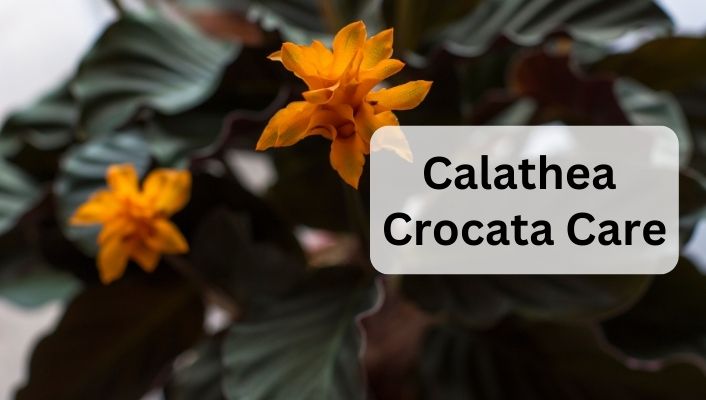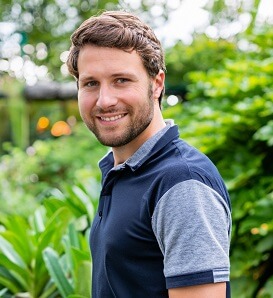Calathea Crocata, also known as the Eternal Flame Plant, can add a pop of vibrant color and tropical beauty to your home.
A mesmerizing living masterpiece, it has dark green leaves with fiery orange or red undersides. But it’s more than that. Gaining confidence in growing this plant will bring you joy and satisfaction.
With this guide, you’ll be able to help your Calathea Crocata thrive by finding the right amount of light and humidity and watering it just right.
Get ready to witness the radiant beauty of this plant as it grows and flourishes in your home!
Post Contents
- Calathea Crocata Overview:
- Calathea Crocata Care & Growing
- Size and Growth
- Calathea Crocata Light Requirements
- Watering the Plant Adequately and Properly
- Temperature Needs
- Best Soil or Potting Mix
- Humidity Needs of Calathea Crocata
- Fertilizing the Plant Properly
- Repotting of Eternal Flame Plant
- Pruning Requirements
- Frequently Asked Questions
- Conclusion
- Author
Calathea Crocata Overview:
| Property | Value |
|---|---|
| Common Name | Eternal Flame Plant |
| Scientific Name | Calathea crocata |
| Family | Marantaceae |
| Origin | South America, specifically Brazil |
| Growth Habit | Perennial herbaceous plant |
| Light Requirement | Bright, indirect light |
| Watering Frequency | Moderate to high |
| Soil Type | Well-draining, fertile soil |
| Temperature | 18-24°C (65-75°F) |
| Humidity | High humidity (60-70%) |
| Height | Up to 2 feet |
| Spread | Up to 2 feet |
| Leaf Color | Dark green with orange or red undersides |
| Flowering | Orange or yellow bracts with small flowers |
| Toxicity | Non-toxic to humans and pets |
Calathea Crocata Care & Growing
Let’s dive into the guide by having an in-depth discussion about the care of this beautiful and extraordinary plant.
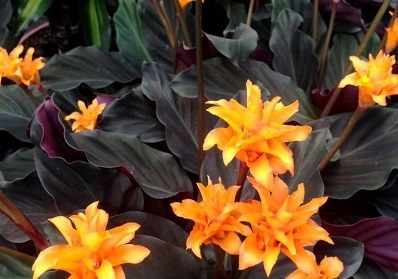
Size and Growth
With an adult height of 32 inches and a narrow width, the plants can be easily grouped in small areas or placed on narrow shelves. Plus, this looks beautiful as well.
Calathea Crocata Light Requirements
Talking about the basic requirement, if you want the best growth, bright colours and healthy production of Crocata flowers. Then situate your Eternal Flame Plant indoors, receiving bright indirect light.
A south-facing window generally produces too much direct sunlight. So, you should probably opt for an east-, west-or north-facing window. This will provide the ideal light for your plant.
Direct sunlight for more than 2 hours per day will cause fading, burned foliage and possible scorching of the leaves. The plant can lose its color too. Likewise, too little light or shade can hinder flowering.
However, it can endure a bit more light during winter than during the hot summer months when the sun is more intense.
Related Post: Calathea Warscewiczii Care & Propagation (Perfect Guide!)
Watering the Plant Adequately and Properly
Calathea crocata grows best with regular watering but remember it’s extremely sensitive to normal tap water. Always use distilled water or store natural rainwater for it.
During the warm growing seasons of spring and summer, water it when the top inch of soil becomes dry, using enough water to run from the pot’s bottom drain holes. This will be enough around once weekly. In winter, you may only have to water every two weeks.
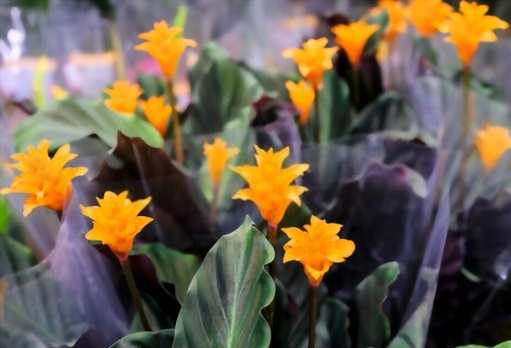
As mentioned above, it’s very important to use the correct type of water, as Eternal Flame Plants are very sensitive and can suffer brown or burned leaves if watered incorrectly. Water types that cause problems include:
- Hard water
- Soft water
- Fluoridated water
- Cold water
- The water of poor quality
Ensure that the plant never sits in standing water because, in this way, root rot can develop. If you have a pot with drain holes inside a decorative pot, empty it of any water after the soil has completely drained.
Temperature Needs
Calathea crocata’s native habitat always stays warm. Therefore, this plant needs a warm indoor environment with temperatures ranging between 65 and 80 Fahrenheit.
For your additional knowledge, Crocatas can never tolerate sudden extreme temperature changes or draughts.
Even if these plants are indoors, temperatures below 55 Fahrenheit can make your Eternal Flame Plant suffer damage. On the other hand, if your indoor temperatures become too hot, the foliage starts curling.
Once your weather warms in spring and summer, you can give your plant a break from growing indoors by placing it outside in a shady location. Care for it as you would while it’s growing inside your home.
Best Soil or Potting Mix
Coming to the preferred soul for the best performance and growth, always choose to grow Calathea crocata in a fertile, lightweight potting mix that contains some peat.
Don’t use normal pure potting soil. Because this mixture is always too heavy and retains too much water leading to rot. Try replicating its native environment, where the plant grows on the forest floor in leaf litter and debris.
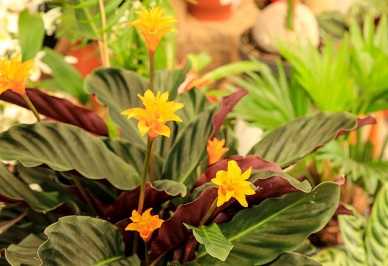
Moreover, you can make your potting soil by mixing about 25 percent peat moss with 75 percent compost or a potting mix rich in organic materials. Just make sure your mixture is lightweight, drains well and isn’t too heavy.
Humidity Needs of Calathea Crocata
Humidity is very important for tropical plants, and you should create a humid environment for your Eternal Flame to live in. It stays the healthiest in high humidity and starts to suffer from problems if conditions aren’t humid enough.
Following are some tips for making a perfect humid environment for your Calathea Crocata:
- Fill a spraying bottle with room temperature distilled or rainwater and mist the leaves every 2 to 3 days. Try to avoid using cold water. Plus, never mist the flowers.
- You can also place the pot on a tray of pebbles and stones to collect the water from the pot’s bottom drain holes.
- Situate the plant in a bathroom that receives adequate lighting.
Remember, these are tropical jungle plants, so they can’t have too much humidity. Just the right, adequate humidity will be perfect.
Also Read:
Fertilizing the Plant Properly
Eternal Flame Plant does not need fertilizer feeding but will benefit from a fertilizer applied every 2 to 3 months during the spring and summer growing seasons. The plant goes through a slowdown in winter and does not need fertilizing.
Try to opt for a water-soluble houseplant fertilizer and apply it when you water. Using fertilizer while watering helps it reach inside the soil and avoids buildup over the soil area. You can also use time-released granules spread on top of the soil. This fertilizer gradually releases the product every time you water the plant.
Repotting of Eternal Flame Plant
You can examine that it’s generally time to repot into a slightly larger container. If the plant is getting too big for the present container, or the root system has started to wrap in circles.
Allowing the root system to stay wrapped in circles can negatively affect the plant’s growth, and if the problem is too bad, the plant may never recover proper growth. Use a terracotta pot as it dries up the excess water more quickly than other plastic ones.
The best time to repot the Calathea crocata is in late spring to early summer when growth has started.
Steps for successful and damage-proof repotting include:
- Select a new container that is slightly larger than the present one. Do not use a very big pot as you add more soil and retain more water, leading to root rot.
- With due care, remove the Eternal Flame Plant from the present container and check the root system for wrapping. Slowly pull the roots apart if excess root wrapping is seen.
- Fill the new container about a quarter full of the potting mix recommended above in the article.
- Place the Calathea crocata in the centre of the pot and fill the remainder with soil mix, packing it around the plant’s base with your fingers.
- Water until it runs from the bottom drain holes and then situates the plant back where it was originally growing.
Pruning Requirements
It’s best to trim off the foliage as it dies naturally, trimming back to the base. You can remove any diseased or damaged leaves, as they won’t correct themselves. You can also trim off the damaged section of the foliage.
Frequently Asked Questions
I see Dead Spots On The Leaf Margins. What’s causing them?
This is a problem generally caused by fluoride toxicity. Solve the problem by avoiding using water or fertilizer container fluoride.
Why Are My Calathea Crocata’s Leaves Losing Their Color?
The plant’s leaves can lose color by overwatering, light levels that are too bright, or lack of fertilizer. Correct the problem by reducing the frequency of water, moving the plant to a location with lower light levels and applying fertilizer at half-strength monthly.
Why Are My Healthy Looking Calathea’s Leaves Wilting?
If the foliage on your plant looks healthy, the problem is the lack of water. Increase the frequency of water applications by applying water when the top inch of the soil is dry.
Is Calathea Crocata Poisonous?
Calathea crocata is considered non-toxic to dogs, cats, horses and people.
Conclusion
Winding up the article, Calathea Crocata is one of the most beautiful-looking houseplants. They need the right care and the right environment to thrive. Once growing successfully, you’ll feel proud over it.
Hope this article has covered all the necessary information about the desired plant. Now you can successfully fulfil your desire for the Eternal Flame Plant.
Some Other Related Plants Guides:
